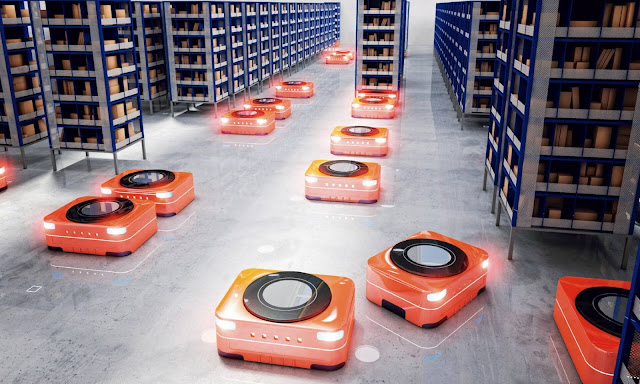Warehouse Robotics Market Is Estimated To Witness High Growth Owing To Increasing Adoption of Automation in Warehouse Operations
 |
| Warehouse Robotics Market |
The global warehouse robotics market is estimated to be valued at US$ 9.88 Bn in 2021 and is expected to exhibit a CAGR of 15.5% over the forecast period 2022-2030, as highlighted in a new report published by Coherent Market Insights.
Market Overview:
Warehouse robotics refers to the use of autonomous machines and systems to
perform various tasks in warehouses, such as picking, packing, sorting, and
transporting goods. These robots can significantly improve operational
efficiency, reduce labor costs, and minimize errors in warehouse operations.
With the increasing need for fast and accurate order fulfillment in the
e-commerce industry, the demand for warehouse robotics is growing rapidly.
Market Key Trends:
One key trend in the warehouse robotics market is the integration of artificial
intelligence (AI) and machine learning (ML) technologies. AI and ML algorithms
help robots in making data-driven decisions, optimizing warehouse operations,
and improving productivity. With advancements in computer vision and sensor
technologies, robots can now navigate complex warehouse environments, identify
objects, and adapt to dynamic situations. This trend is expected to drive the
growth of the warehouse robotics market as companies strive for more efficient
and flexible warehouse operations.
PEST Analysis:
Political: The political factors affecting the warehouse robotics market
include government regulations and policies related to robotics and automation.
Governments may impose restrictions or provide incentives for the adoption of
robotics in warehouses. For example, some countries may promote the use of
robotics to address labor shortages, while others may impose regulations to
protect jobs.
Economic: The economic factors influencing the warehouse robotics market
pertain to the overall economic conditions and trends. Factors such as GDP
growth, disposable income, and consumer spending patterns can impact the demand
for automated solutions in warehousing. Additionally, labor costs and the return
on investment for implementing robotics play a significant role in the economic
feasibility of warehouse automation.
Social: Social factors include societal attitudes and preferences towards
automation and robotics. Factors like the acceptance of automation technology
by warehouse workers and the general population can influence the adoption rate
of robotics. The availability of skilled labor in the market and the potential
impact of automation on employment are also important social considerations.
Technological: Technological factors play a crucial role in the warehouse
robotics market. Advances in robotics technology, including artificial
intelligence, machine learning, and sensor technology, drive innovation and
enhance the capabilities of warehouse robots. Integration with other emerging
technologies like Internet of Things (IoT) and cloud computing further optimize
warehouse operations and improve efficiency.
Key Takeaways:
The global
warehouse robotics market is expected to witness high growth,
exhibiting a CAGR of 15.5% over the forecast period (2022-2030). This growth
can be attributed to several factors. Firstly, the increasing need for
efficient order fulfillment and inventory management in the e-commerce sector
is driving the adoption of warehouse robotics. With the rise in online
shopping, warehouses are under pressure to handle large volumes of orders
quickly and accurately, leading to the demand for automated solutions.
Regionally, the Asia-Pacific is projected to be the fastest-growing and
dominating region in the warehouse robotics market. Factors such as rapid
industrialization, expanding e-commerce sector, and increasing investments in
automation technologies contribute to the growth of the market in this region.
The Asia-Pacific region is witnessing significant growth due to the presence of
large consumer markets like China and India, along with the increasing focus on
cost-effective and scalable automation solutions.
Key players operating in the warehouse robotics market include Locus Robotics,
ABB Limited, Honeywell International Inc., Fanuc Corporation, Geek+ Inc., TGW
Logistics Group GMBH, Omron Adept Technologies, Swisslog Holding AG (KUKA AG),
Singapore Technologies Engineering Ltd (Aethon Incorporation), Yaskawa Electric
Corporation (Yaskawa Motoman), InVia Robotics Inc., Fetch Robotics Inc., Syrius
Robotics, Grey Orange Pte Ltd, Hangzhou Hikrobot Technology Co. Ltd, and
Toshiba Corporation. These key players are driving innovation in warehouse
automation and are actively involved in partnerships, acquisitions, and product
launches to gain a competitive edge in the market.
In conclusion, the warehouse robotics market is poised
for high growth due to the increasing adoption of automation in warehouse
operations. The integration of AI and ML technologies is a key trend that is
expected to further enhance the capabilities and efficiency of warehouse
robotic systems.



Comments
Post a Comment